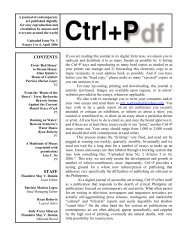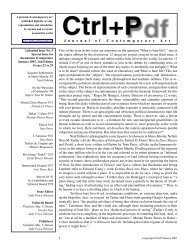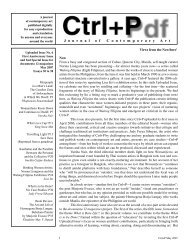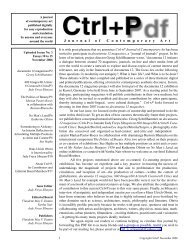Issue 15 - Pdf Ctrl+P - CTRL+P: a journal of contemporary art
Issue 15 - Pdf Ctrl+P - CTRL+P: a journal of contemporary art
Issue 15 - Pdf Ctrl+P - CTRL+P: a journal of contemporary art
You also want an ePaper? Increase the reach of your titles
YUMPU automatically turns print PDFs into web optimized ePapers that Google loves.
The MOPA was dedicated to Philippine modern <strong>art</strong> in contradistinction to another<br />
Imelda brainchild, the Metropolitan Museum <strong>of</strong> Manila or the MET that was decidedly<br />
international in its projection, having opened in 1977 with loans from the Brooklyn<br />
Museum and other galleries or collections in the United States, 13 most notably Armand<br />
Hammer’s. Like MOPA, which commenced with a Federico Aguilar Alcuaz event under<br />
Luz’s directorship, the MET was directed by Arturo Luz. Through the years, it hosted the<br />
exhibitions <strong>of</strong> Paul Klee and Joseph Beuys, Byzantine icons, Yugoslav naïf paintings, the<br />
Vatican Collection, among countless others. The MET after Marcos, in some version <strong>of</strong><br />
the developmentalist model, pursued an “<strong>art</strong> for all” vision, and interestingly this meant<br />
overturning the Luz museography. According to Felice Sta. Maria, MET President from<br />
1986 to 1993: “For Philippine museums, adherence to the Western museum paradigm<br />
led to an isolationist image, incomprehensible texts, and ineffective programs—a total<br />
museological dysfunction…It dampened the raison d’etre <strong>of</strong> museums as cultural and<br />
educational institutions for the general public.” 14 It may seem then that post-Marcos<br />
likewise meant post-Luz.<br />
Fourth, the somewhat unpredictable and unsystematic admission <strong>of</strong> gifts, contributions,<br />
and <strong>art</strong> left behind by <strong>art</strong>ists, a practice that was practically dependent on the social<br />
networks <strong>of</strong> Imelda Marcos and Raymundo Albano, who did not have the budget to buy.<br />
There had been purchases after the Marcos period, governed by no clear-cut acquisition<br />
guidelines. This could be attributed to an anti-CCP outlook that infected the CCP, that<br />
is, an aversion to curatorial engineering. Reigning in a scenario soaked in people-power<br />
euphoria were the tedious and ultimately reactionary concepts <strong>of</strong> decolonization and<br />
indigenization, informed by the populist nationalism <strong>of</strong> a coalition <strong>of</strong> anti-dictatorship<br />
forces. The plurality that was unleashed by the fall <strong>of</strong> the house <strong>of</strong> Marcos found its expression<br />
in Piglas: Art at the Crossroads, the come-one, come-all exhibition at the Center<br />
in 1986 that, as it is in all days <strong>of</strong> deliverance, let the barbarians at the gate, anybody<br />
who thought <strong>of</strong> himself or herself as <strong>art</strong>ist, crash the fold <strong>of</strong> culture’s grand catacomb.<br />
Marian Pastor Roces interjects: “It was extremely difficult to keep the exhibit free from<br />
the emotional issues surrounding the CCP itself. It was impossible to screen out works<br />
which did not seem to have anything to do with <strong>art</strong> at the crossroads. It was, to say the<br />
least, impossible to ‘curate.’” <strong>15</strong> This could only be indicative <strong>of</strong> the semblance <strong>of</strong> strict<br />
curatorial control in the previous years and the irresistible urge to negate it when the<br />
p<strong>art</strong>y was finally over.<br />
In light <strong>of</strong> these developments at the CCP, one way <strong>of</strong> piecing together the sources<br />
<strong>of</strong> the collection would be to match exhibitions at the CCP and the existence <strong>of</strong> objects<br />
in these exhibitions with the registry. For instance, Lani Maestro’s work in the collection<br />
might have come from her exhibition at the CCP Museum Hallway in 1981 based on the<br />
visual documentation. Cid Reyes also confides that Arturo Luz bought some <strong>of</strong> his works<br />
at his Chroma exhibition at the Hyatt in 1973 on behalf <strong>of</strong> Imelda; and one <strong>of</strong> these, the<br />
tondo Volta Redonda I, is in the collection. And we take note <strong>of</strong> a Betsy Westendorp de<br />
Brias exhibition <strong>of</strong> Marcosiana in 1975; a portrait <strong>of</strong> Ferdinand Marcos is in the storage.<br />
To summarize, the collection at the Center was assembled under the broad rubrics <strong>of</strong><br />
commission, purchase, and gift. A curious note: In 1976, in time for the International<br />
Monetary Fund-World Bank Meeting, an exhibition <strong>of</strong> reproductions <strong>of</strong> modern masters<br />
(Picasso, Bacon, Magritte, Klee) was held at the CCP to shore up a proposal for a collection<br />
<strong>of</strong> international <strong>contemporary</strong> <strong>art</strong> at the Center.<br />
Ethic <strong>of</strong> Collecting<br />
It may be useful to tentatively assume that the logic <strong>of</strong> collecting at the Center was<br />
contingent on a level <strong>of</strong> connoisseurship represented by the taste <strong>of</strong> Imelda Marcos and<br />
the coterie around her: Leandro Locsin, Arturo Luz, and Roberto Chabet. At the outset,<br />
a p<strong>art</strong>icular type <strong>of</strong> internationalist abstraction <strong>of</strong> a late modern pedigree would frame<br />
this disposition, although Imelda also favored nativist inclinations in the works <strong>of</strong>, let us<br />
say, Carlos Francisco <strong>of</strong> Angono, Rizal. Locsin’s design <strong>of</strong> the building, a cross between<br />
brutalist minimalism and nativist quotation <strong>of</strong> the bahay kubo (nipa hut) morphology,<br />
set the tone, inflected by the exacting predilections <strong>of</strong> Luz and, later, Chabet. They<br />
36 <strong>Ctrl+P</strong> September 2009







